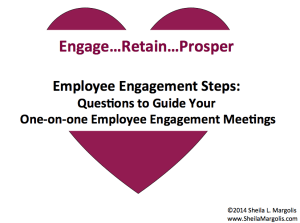Do you hold one-on-one employee engagement meetings?
After conducting an employee engagement survey, often, one technique used by many organizations to increase engagement is to hold effective one-on-one employee meetings. To clarify, in these meetings, each employee spends one-on-one time with the employee’s manager / immediate supervisor. Some people call these “meetings.” However, others call them “conversations” or “check-ins.”
The idea is to make these sessions informal, positive, and productive. So be sure to give them a name that communicates this focus.
Conduct one-on-one employee meetings because employee engagement is an individual thing
The reason for meeting one-on-one is that employee engagement is a personal thing. Therefore, managers / immediate supervisors are in the best position to know the employees they manage. That is to say, they are in the best position to discover what will drive that person’s engagement. Employees stay for things they get uniquely from their immediate supervisors. The immediate supervisor has more power than anyone else in keeping employees engaged.
Many engagement strategies are most effective when tailored to the needs and preferences of each employee. Therefore, having opportunities to discuss these needs and preferences is often best done through effective one-on-one meetings. These meetings are ideal for showing your employees that you genuinely care.
By focusing on each employee in a positive, non-threatening way, managers can drive engagement. They can also personalize how to most effectively help each person they supervise.
Managers who conduct these meetings should act more like a coach or facilitator asking questions about how things are going, what is working or not working, and most importantly, how the manager can help.
Meet frequently–preferably weekly, but at least monthly
How long should this one-on-one meeting last? If you meet with your employees weekly, then the conversation may only need to be 20 to 30 minutes. Keep in mind that these meetings can be in-person or virtual.
What if weekly meetings are hard to schedule. Then, consider every other week or, at the least, monthly. Those meetings will require more time–up to an hour.
If you are having one-on-ones quarterly or even less frequently, then you may be hindering engagement efforts in your company.
Use these questions to guide your one-on-one employee meetings
The slideshow “Employee Engagement Steps: Questions to Guide Your One-on-one Employee Engagement Meetings” provides an overview of questions to guide your one-on-one conversations in your Employee Engagement Meetings.
Try to incorporate topics that focus on both short-term and long-term issues.
Prior to the meeting, employees should think about how things are going for them, their priorities, and any problems they have encountered or concerns that they have that could be remedied by the manager. The goal is for the employee to do most of the talking and the manager to do most of the listening.
Below is a link to a slideshow on these one-on-one employee meetings. It provides questions to guide your meetings.
At the end of the meeting, be sure to compile things learned and action items. Documenting agreements and next steps improves the likelihood that the actions will be carried out. And action is key to effective meeting management.
Contact Sheila to discuss how you can improve employee engagement
Contact Sheila to help you improve employee engagement in your organization. Her management consulting firm Workplace Culture Institute is based in Atlanta, serving clients globally. Use the contact form to email Sheila.
